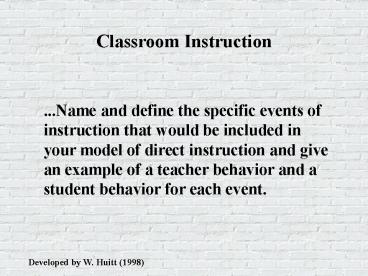Direct Instruction - PowerPoint PPT Presentation
1 / 26
Title:
Direct Instruction
Description:
4. Initial student practice, checking for understanding, feedback & correctives. ... Direct Instruction: Practice. Allows students to work with little or no ... – PowerPoint PPT presentation
Number of Views:52
Avg rating:3.0/5.0
Title: Direct Instruction
1
Classroom Instruction
...Name and define the specific events of
instruction that would be included in your model
of direct instruction and give an example of a
teacher behavior and a student behavior for each
event.
Developed by W. Huitt (1998)
2
Direct Instruction
In the U. S. the most often used measures of
student learning are scores on standardized tests
of basic skills.
3
Direct Instruction
Rosenshines model of direct instruction includes
seven events (specific teacher or student
activities)
1. Provide overview.
2. Review, checking previous day's work.
3. Present new content skills.
4. Initial student practice, checking for
understanding, feedback correctives.
5. Independent practice.
6. Frequent tests.
7. Homework weekly and monthly reviews.
4
Direct Instruction
These are very similar to the events suggested by
Slavin (1994) Slavin, R. (1994).
Educational psychology (5th ed.). Boston Allyn
Bacon.
1. State learning objective and orient students.
2. Review prerequisites.
3. Present new material.
4. Conduct learning probes.
5. Provide independent practice.
6. Assess performance and provide feedback.
7. Provide distributed practice and review.
5
Direct Instruction
6
Direct Instruction
However, all of these models have a common
viewpoint that the teacher should be the focus of
the process of instruction.
7
A Transactional Model of Direct Instruction
The transactional model includes four major
categories of instructional events
- Presentation
- Practice
- Assessment Evaluation
- Monitoring Feedback
8
A Transactional Model of Direct Instruction
Each category includes specific events of
instruction that incorporates both a teacher
behavior and a student behavior for that event.
9
A Transactional Model of Direct Instruction
Presentation includes five events, three of which
are considered together in a subcategory labeled
Overview.
- Overview
- Review
- What
- Why
- Explanation
- Demonstration
10
Direct Instruction Presentation
Overview Review
Provides an opportunity for students to recall
/or examine what they have already learned in
preparation for current lesson
Teacher
Focus on prerequisite skills and concepts check
homework link the lesson to previous ones
review the previous lesson
Student
11
Direct Instruction Presentation
Overview What
Presents the specific concept(s) and skill(s) to
be learned
Teacher
Read a stated objective for the lesson hear
what the topic of the lesson is see what they
will be able to do at the end of a lesson
Student
12
Direct Instruction Presentation
Overview Why
States a reason or a need for learning the
skill(s) or concept(s)
Teacher
See how the lesson is related to the real world
relate the lesson to their own interests discuss
how the skill or concept can be applied to
other subject areas
Student
13
Direct Instruction Presentation
Explanation
Develops or explains the concepts and skills to
be learned
Teacher
Hear an explanation use manipulative materials
have class discussions watch videos read
explanations in textbooks interact with computer
Student
14
Direct Instruction Presentation
Demonstration
Probes students as to their initial understanding
of concepts and skills
Teacher
Answer teacher questions verbalize
understandings model demonstrated processes
generate examples and non-examples of a concept
Student
15
Direct Instruction Practice
Practice includes three events
- Guided Practice
- Independent Practice
- Periodic Review
16
Direct Instruction Practice
Guided Practice
Closely supervises the students as they begin to
develop increased proficiency by completing one
or two short tasks at a time
Teacher
Read a paragraph aloud complete one or two math
problems complete an activity on the board,
while others do the same activity at their seats
Student
17
Direct Instruction Practice
Independent Practice
Allows students to work with little or no teacher
interaction
Teacher
Complete seatwork assignments complete homework
assignments play games related to specific
skills or concepts
Student
18
Direct Instruction Practice
Periodic Review
Provides students opportunity to have distributed
practice on previously covered content and skills
Teacher
Demonstrate retention of previously learned
concepts and skills
Student
19
Direct Instruction Assessment Evaluation
Assessment and evaluation includes two events
- Daily success
- Mastery
20
Direct Instruction Assessment Evaluation
Daily Success
Checks students work each day and offers
corrective instruction as necessary
Teacher
Complete independent work at or above a given
level of proficiency
Student
21
Direct Instruction Assessment Evaluation
Mastery
Checks students work at the end of each unit of
instruction
Teacher
Demonstrate knowledge and application of
concepts and skills at or above a given level of
proficiency
Student
22
Direct Instruction Monitoring Feedback
Monitoring and feedback also includes two events
- Cues and prompts
- Corrective feedback
23
Direct Instruction Monitoring Feedback
Cues Prompts
Provides students with signals and reminders
designed to sustain the learning activity and to
hold students accountable
Teacher
Attend to signals and/or reminders continue
working on assigned activity
Student
24
Direct Instruction Monitoring Feedback
Corrective Feedback
Tells students whether their answers are correct
or incorrect and why
Teacher
Read correct answers aloud write correct
solutions to math problems on board support
answers to reading comprehension questions by
reading aloud from the text
Student
25
Direct Instruction
In general, all direct instruction models have
the following common principles
- More teacher-directed instruction (gt 50) and
less seatwork (lt 50)
- Active presentation of information (could be by
teacher, computer, another student)
- Clear organization of presentation
- Step-by-step progression from subtopic to
subtopic (based on task analysis)
26
Direct Instruction
In general, all direct instruction models have
the following common principles
- Use many examples, visual prompts, and
demonstrations.
- Constant assessment of student understanding
(before, during and after the lesson).
- Alter pace of instruction based on assessment of
student understanding
- Effective use of time and maintaining students'
attention






























